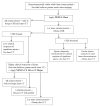Selective chest imaging for blunt trauma patients: The national emergency X-ray utilization studies (NEXUS-chest algorithm)
- PMID: 27838036
- PMCID: PMC5177494
- DOI: 10.1016/j.ajem.2016.10.066
Selective chest imaging for blunt trauma patients: The national emergency X-ray utilization studies (NEXUS-chest algorithm)
Abstract
Chest imaging plays a prominent role in blunt trauma patient evaluation, but indiscriminate imaging is expensive, may delay care, and unnecessarily exposes patients to potentially harmful ionizing radiation. To improve diagnostic chest imaging utilization, we conducted 3 prospective multicenter studies over 12years to derive and validate decision instruments (DIs) to guide the use of chest x-ray (CXR) and chest computed tomography (CT). The first DI, NEXUS Chest x-ray, consists of seven criteria (Age >60years; rapid deceleration mechanism; chest pain; intoxication; altered mental status; distracting painful injury; and chest wall tenderness) and exhibits a sensitivity of 99.0% (95% confidence interval [CI] 98.2-99.4%) and a specificity of 13.3% (95% CI, 12.6%-14.0%) for detecting clinically significant injuries. We developed two NEXUS Chest CT DIs, which are both highly reliable in detecting clinically major injuries (sensitivity of 99.2%; 95% CI 95.4-100%). Designed primarily to focus on detecting major injuries, the NEXUS Chest CT-Major DI consists of six criteria (abnormal CXR; distracting injury; chest wall tenderness; sternal tenderness; thoracic spine tenderness; and scapular tenderness) and exhibits higher specificity (37.9%; 95% CI 35.8-40.1%). Designed to reliability detect both major and minor injuries (sensitivity 95.4%; 95% CI 93.6-96.9%) with resulting lower specificity (25.5%; 95% CI 23.5-27.5%), the NEXUS CT-All rule consists of seven elements (the six NEXUS CT-Major criteria plus rapid deceleration mechanism). The purpose of this review is to synthesize the three DIs into a novel, cohesive summary algorithm with practical implementation recommendations to guide selective chest imaging in adult blunt trauma patients.
Copyright © 2016 Elsevier Inc. All rights reserved.
Conflict of interest statement
All authors were required to disclose any and all commercial, financial, and other relationships in any way related to the subject of this article as per ICMJE conflict of interest guidelines (see www.icmje.org).
Figures

Similar articles
-
Derivation and validation of two decision instruments for selective chest CT in blunt trauma: a multicenter prospective observational study (NEXUS Chest CT).PLoS Med. 2015 Oct 6;12(10):e1001883. doi: 10.1371/journal.pmed.1001883. eCollection 2015 Oct. PLoS Med. 2015. PMID: 26440607 Free PMC article.
-
NEXUS chest: validation of a decision instrument for selective chest imaging in blunt trauma.JAMA Surg. 2013 Oct;148(10):940-6. doi: 10.1001/jamasurg.2013.2757. JAMA Surg. 2013. PMID: 23925583
-
Prevalence and Diagnostic Performance of Isolated and Combined NEXUS Chest CT Decision Criteria.Acad Emerg Med. 2016 Aug;23(8):863-9. doi: 10.1111/acem.13010. Epub 2016 Aug 1. Acad Emerg Med. 2016. PMID: 27163732
-
Sternal fracture in the age of pan-scan.Injury. 2015 Jul;46(7):1324-7. doi: 10.1016/j.injury.2015.03.015. Epub 2015 Mar 14. Injury. 2015. PMID: 25817167 Review.
-
Predictors of abnormal chest CT after blunt trauma: a critical appraisal of the literature.Clin Radiol. 2009 Mar;64(3):272-83. doi: 10.1016/j.crad.2008.09.004. Epub 2008 Nov 13. Clin Radiol. 2009. PMID: 19185657 Review.
Cited by
-
Radiation protection: Factors influencing compliance to referral guidelines in minor chest trauma.Eur Radiol. 2018 Apr;28(4):1420-1426. doi: 10.1007/s00330-017-5093-4. Epub 2017 Oct 27. Eur Radiol. 2018. PMID: 29079913
-
Assessing the role of chest CT in minor blunt trauma: evaluation of the NEXUS decision instrument across an expanded population.Eur J Trauma Emerg Surg. 2025 Jan 27;51(1):84. doi: 10.1007/s00068-024-02692-8. Eur J Trauma Emerg Surg. 2025. PMID: 39869184
-
Correlation Between the Revised Physiological Trauma Score and CT Scan Results.Cureus. 2024 Aug 22;16(8):e67534. doi: 10.7759/cureus.67534. eCollection 2024 Aug. Cureus. 2024. PMID: 39310627 Free PMC article.
-
Thoracic wall trauma-misdiagnosed lesions on radiographs and usefulness of ultrasound, multidetector computed tomography and magnetic resonance imaging.Quant Imaging Med Surg. 2017 Aug;7(4):384-397. doi: 10.21037/qims.2017.08.02. Quant Imaging Med Surg. 2017. PMID: 28932697 Free PMC article. Review.
-
Routine versus selective chest and abdominopelvic CT-scan in conscious blunt trauma patients: a randomized controlled study.Eur J Trauma Emerg Surg. 2018 Feb;44(1):9-14. doi: 10.1007/s00068-017-0842-2. Epub 2017 Sep 25. Eur J Trauma Emerg Surg. 2018. PMID: 28948295 Clinical Trial.
References
-
- American College of Surgeons. Advanced Trauma Life Support for Doctors: Student Course Manual. 7. Chicago, IL: American College of Surgeons; 2008.
-
- Wisbach GG, Sise MJ, Sack DI, et al. What is the role of chest X-ray in the initial assessment of stable trauma patients? J Trauma. 2007;62(1):74–79. - PubMed
-
- Broder J, Warshauer DM. Increasing utilization of computed tomography in the adult emergency department, 2000-2005. Emerg Radiol. 2006;13:25–30. - PubMed
-
- Larson DB, Johnson LW, Schnell BM, Salisbury SR, Forman HP. National trends in CT use in the emergency department: 1995-2007. Radiology. 2011;258:164–73. - PubMed
Publication types
MeSH terms
Grants and funding
LinkOut - more resources
Full Text Sources
Other Literature Sources
Medical

